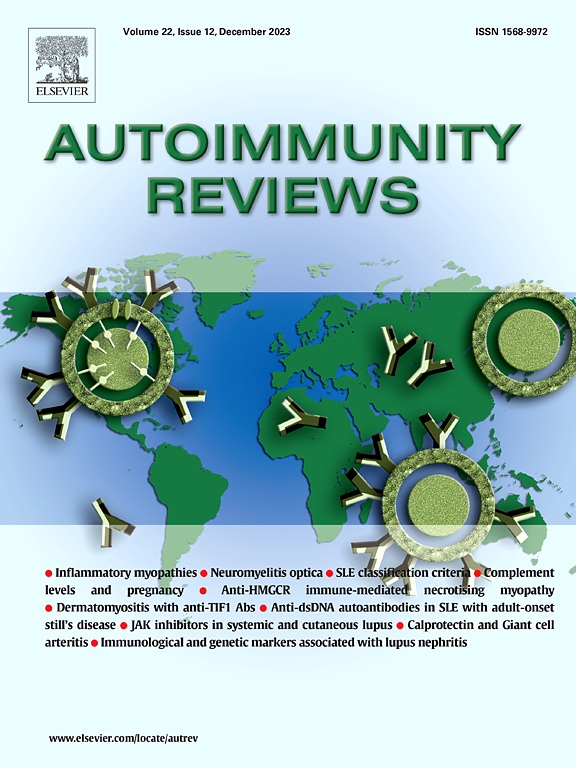The burden of extracutaneous manifestations in juvenile localized scleroderma: A literature review
IF 8.3
1区 医学
Q1 IMMUNOLOGY
引用次数: 0
Abstract
Objectives
Juvenile Localized Scleroderma (JLS) is an autoimmune disease leading to fibrosis of skin and subcutaneous tissues affecting children, that is characterized by extracutaneous manifestations (ECM) in about 20 % of patients. JLS and ECM can cause severe disabilities, potentially impacting patients' quality of life (QoL). We aimed to systematically review studies reporting ECM in young patients with JLS.
Methods
Pubmed, Cochrane and Scopus databases were approached to identify studies evaluating ECM in children with LS. Selected papers focusing on QoL and multidisciplinary approach were separately analysed.
Results
At the end of the selection process, 15 papers (encompassing 3604 children) focused on the description of ECM were included. Overall, ECM were reported in 958/3604 (26.5 %) children, and the 3 most frequent ones were musculoskeletal (24 %), neurological (10.3 %) and odontostomatological (7.6 %). Six papers (435 patients) focusing on QoL in children with JLS resulted comparable. Three studies focusing on the role of a multidisciplinary team in the management of children and adolescents with JLS and ECM were also selected (216 children).
Conclusions
Almost one-third of patients with JLS may present several clinical problems other than skin lesions that should be managed by a multidisciplinary team. However, evidence on the efficacy of a multispecialty management is still lacking. The impact of ECM on QoL of these patients may be underestimated, as no specifically developed assessment tool has been applied so far, but recently proposed overall disease severity and disease-specific patient-reported outcome measures may improve the evaluation of this important clinical aspect.
青少年局限性硬皮病的皮外表现负担:文献综述。
目的:青少年局限性硬皮病(JLS)是一种影响儿童的导致皮肤和皮下组织纤维化的自身免疫性疾病,其特征是约20% %的患者有皮肤外表现(ECM)。JLS和ECM可导致严重的残疾,潜在地影响患者的生活质量。我们的目的是系统地回顾报道年轻JLS患者ECM的研究。方法:通过Pubmed、Cochrane和Scopus数据库,筛选评估LS患儿ECM的研究。选取关注生活质量和多学科方法的论文分别进行分析。结果:在选择过程结束时,15篇关于ECM描述的论文(包括3604名儿童)被纳入。总体而言,958/3604名儿童(26.5% %)报告了ECM,其中最常见的3种是肌肉骨骼(24% %)、神经系统(10.3 %)和牙口腔(7.6 %)。6篇研究JLS患儿生活质量的论文(435例)结果具有可比性。还选择了三项研究,重点关注多学科团队在患有JLS和ECM的儿童和青少年管理中的作用(216名儿童)。结论:几乎三分之一的JLS患者可能会出现除皮肤病变以外的一些临床问题,这些问题应该由多学科团队来处理。然而,关于多专业管理的有效性的证据仍然缺乏。ECM对这些患者生活质量的影响可能被低估,因为到目前为止还没有专门开发的评估工具,但最近提出的总体疾病严重程度和疾病特异性患者报告的结果测量可能会改善对这一重要临床方面的评估。
本文章由计算机程序翻译,如有差异,请以英文原文为准。
求助全文
约1分钟内获得全文
求助全文
来源期刊

Autoimmunity reviews
医学-免疫学
CiteScore
24.70
自引率
4.40%
发文量
164
审稿时长
21 days
期刊介绍:
Autoimmunity Reviews is a publication that features up-to-date, structured reviews on various topics in the field of autoimmunity. These reviews are written by renowned experts and include demonstrative illustrations and tables. Each article will have a clear "take-home" message for readers.
The selection of articles is primarily done by the Editors-in-Chief, based on recommendations from the international Editorial Board. The topics covered in the articles span all areas of autoimmunology, aiming to bridge the gap between basic and clinical sciences.
In terms of content, the contributions in basic sciences delve into the pathophysiology and mechanisms of autoimmune disorders, as well as genomics and proteomics. On the other hand, clinical contributions focus on diseases related to autoimmunity, novel therapies, and clinical associations.
Autoimmunity Reviews is internationally recognized, and its articles are indexed and abstracted in prestigious databases such as PubMed/Medline, Science Citation Index Expanded, Biosciences Information Services, and Chemical Abstracts.
 求助内容:
求助内容: 应助结果提醒方式:
应助结果提醒方式:


